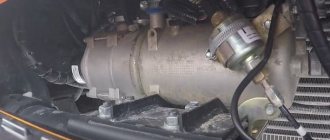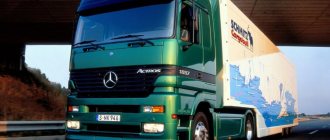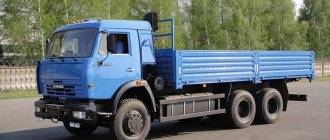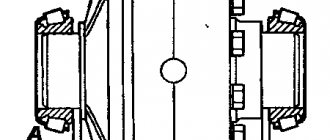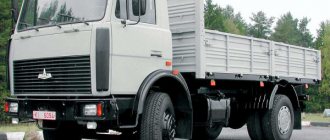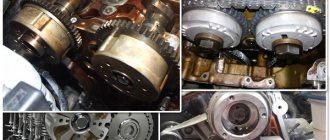What is car engine torque in simple words
Torque and power of VAZ engines. As can be seen from the graphs, maximum power is achieved only at maximum revs, while peak torque is between 3000 and 4500 revs.
To answer this question in simple words, you must first find out what is meant by the terms “power”, “torque”, and also the number of revolutions. With the first of these characteristics the situation is somewhat simpler, since all those who studied well in high school know that power is the work produced per unit of time.
An internal combustion engine, consuming fuel, converts the thermal energy of its combustion into kinetic energy, while doing work. It consists of rotating the crankshaft, and this indicator is measured in revolutions per minute. Accordingly, the frequency with which the combustion of the fuel mixture occurs in the cylinders of the internal combustion engine directly determines the work performed by the engine and its power. This dependence is directly proportional.
As for torque, not everything is as obvious with it as with power and number of revolutions. It is, in fact, a quantity derived from them and represents the product of force on the lever arm. Since the force (in this case, the one that occurs during fuel combustion and acts on the piston) is measured in physics in newtons, and the length (in this case, the length of the crankshaft crank arm) is measured in meters, the unit of measurement for torque is Nm.
Thus, it turns out that torque is the force that the engine develops. It is its value that determines the traction force that ensures the acceleration of the car and its movement. Consequently, the greater the torque, the faster the car, which means the better its dynamics. Since the force acting on the piston during fuel combustion increases with increasing engine displacement, the larger it is, the higher the torque.
It should be noted that the characteristics of internal combustion engines always indicate the maximum power that they are capable of developing. Torque determines how quickly it is achieved and is therefore specified for a specific speed. In other words, it determines how quickly the power unit “selects” the power potential that is inherent in it by the designers. That is why, for example, when driving quite calmly at low speeds (up to 2500 rpm), for rapid acceleration, the most preferable engine is the one that has the maximum torque at them.
Peaks and valleys on the chart
In real operation, full torque is rarely needed, just in those cases when you press the gas pedal to the floor and hope that the engine will “pull out”; the rest of the time it is less than the maximum at these speeds. But we already know that the torque changes not only under the influence of pressing the gas pedal (mechanical or electronic), but also with revolutions. At different speeds, the processes occurring in the combustion chamber of the engine are different. Additional systems, such as boost, timing control systems and others, further change the filling of the combustion chamber, the amount of fuel and the ignition timing, and as a result, the quality and power of the power stroke depend on the engine speed. Even if there are no electronic control systems, the amount of air entering the cylinder, the amount of exhaust remaining and the optimal ignition timing all change with rpm. At very low speeds there is too much residual gas in the cylinder or detonation is too likely, so torque at low speeds is usually much less than maximum. At medium speeds, the engine “comes to life” - due to pulsations in the intake manifold, more air enters the cylinders, less residual gases, and therefore torque increases. If the car has a turbine or supercharger, then they begin to work at full capacity. But with increasing speed, mechanical losses due to friction of piston rings, friction and inertial losses in the timing belt, heating of oil in bearings, etc. also increase. etc., and the quality of the work process does not improve or even begins to decline. As a result, at high speeds the torque begins to decrease due to increasing losses. And at some point, a turbocharged engine no longer has enough turbine performance and the torque also begins to decrease. Now let's look at the graph of a typical naturally aspirated (that is, naturally aspirated) engine from the 90s, where there are curves not only for torque, but also for power.
But a turbo engine of a similar volume, its torque in the mid-speed zone is electronically limited, often at the limit of strength of the cylinder-piston group, and the power graph is also very “smooth”. It is clearly noticeable how much higher his power is at the beginning and middle of the graph.
Pay attention specifically to the power curve. It rises steeply where the moment is large, and almost does not grow where it falls. The explanation for this is very simple: Power is how much work a motor can do in a second. For an internal combustion engine, the power in kilowatts at each point on the graph can be obtained by multiplying the engine torque in newtons by the number of revolutions per minute and dividing by 9549, that is, something like this:
Consequently, the engine power at any speed depends only on the torque at these speeds, and the maximum power is obtained at the point at which the torque is already decreasing, but at the same time the product of power and speed is still increasing. And to increase maximum power, you can simply increase the torque at high speeds or make it decrease less quickly. Take a look at a typical graph of a high-revving Honda engine - that's exactly what the Japanese did.
I hope the point of view of those who say that “power is not important - only the moment is important” is clear enough? Once again: power as such depends directly on torque and is itself a mathematical, calculated quantity that cannot be measured separately from torque. Torque, in essence, reflects the power that will be available at “partial” engine speeds, but simply when you press the gas when overtaking. And the more moments, the better! After all, the power at these speeds will be higher. And the more power, the more energy you can give to the car, the better the acceleration dynamics. And maximum power primarily affects the maximum speed of the car. Indeed, with correctly calculated gear ratios of the main gear and gearbox, it turns out that the maximum speed is achieved when the expended power is equal to the engine power. And the power of all losses depends on the speed of movement, primarily on air resistance and rolling resistance of the wheels, and at some point it will definitely coincide with the power of the motor, and it is this speed that will be maximum. There are, of course, miscalculations when the engine either cannot develop maximum power speed, or already “rests against” the limiter, but this does not happen very often.
Popular mechanics on the crankshaft
The rotating shaft of any engine resists with great force attempts to slow it down.
Just like the car itself resists headwinds and rolling friction of the wheels. But with linear motion, the physics is clearer, the resistance force is applied in the opposite direction to the pushing force, all this can be measured quite unambiguously. In rotational motion, the force depends on the point along the radius at which resistance to rotation is applied. The farther this point is from the center, the less force is required, very similar to the lever rule, which is known to a much larger circle of people who do not remember physics very well. That is, to accurately characterize the engine’s ability to overcome the load, the radius must also be taken into account.
This is why the concept of torque (T) was invented - this is force multiplied by the distance from the axis of rotation, or the lever arm, if it’s clearer. The greater the force and the longer the lever (radius of the flywheel or wheel), the greater the torque. It is measured, accordingly, in Newton meters, where Newton is the standard unit of measurement of force, but what a meter is is hardly worth explaining.
How torque is created in a piston internal combustion engine and how it is increased
If you imagine a piston connected to the crankshaft journal through a connecting rod, it becomes clear that the CM is uniquely determined by the pressure on the piston. From here there are several conclusions:
- the larger the area of the piston bottom and the gas pressure above it, the higher the torque, which means it is necessary to increase the filling of the cylinder with the useful mixture or the engine displacement;
- if the mixture is compressed more strongly, then the pressure will be greater, hence engines with a high compression ratio have an advantage;
- The objective limits for the infinite growth of torque will be the strength of parts and combustion characteristics, and this is what automotive engineers are working on.
Naturally, car creators do not limit themselves to piston engines, but so far the only real competitor of the internal combustion engine, the electric motor, does not have the problem of torque so acutely; if it is indicated at all, it is only for advertising purposes. But in any case, we need to find out what engine torque affects and why so much attention is paid to it. Not by engineers, for them it is really very important, but by the world of car consumers.
Power or torque - what's more important?
If we conduct a comparative assessment of two engine performance characteristics - power and torque, then the following facts become obvious:
- torque on the crankshaft is the main parameter characterizing the operation of the power unit;
- engine power is a secondary performance characteristic of the motor, which, in essence, is a derivative of torque;
- the dependence of power on torque is expressed by the relation: P = M*n, where P is power, M is torque, n is the number of crankshaft revolutions per minute;
- engine power is linearly dependent on the crankshaft speed: the higher the speed, the greater the engine power (naturally, up to certain limits);
- torque also increases with increasing engine speed, but having reached its maximum value (at a certain crankshaft speed), its performance decreases, regardless of further increase in speed (the graph of torque versus engine speed looks like an inverted parabola).
Gasoline and diesel engines
Gasoline engines do not have the highest performance. A gasoline engine can reach its almost maximum values at an average speed of 3-4 thousand. However, a gasoline engine is capable of quickly increasing power and spinning up to seven or even eight thousand rpm. And if we take into account the above formulas, it becomes clear that at such speeds the power can increase several times.
As for diesel engines, they do not have high revolutions and, as a rule, their maximum is five, or even only three thousand revolutions. In this regard, a diesel engine definitely loses to a gasoline engine. But the torque of a diesel engine is several times higher than that of its gasoline counterpart and, in addition, it is available almost from idle.
What's more important: torque or power?
To understand this problem, we can give a simple example. Let's say, you can take two engines from AUDI, one gasoline 2.0 FSI (torque - 200 Nm, power - 150 hp), and the other diesel (power 140 hp and torque 320 Nm). After testing in various modes, it turns out that a diesel engine is more powerful than a gasoline engine in the range from 1 to 4.5 thousand revolutions. Moreover, the power will be higher by 30, or even 40 “horses,” which is not small.
It follows from this that you should not pay attention solely to power, since often a smaller engine with a higher torque turns out to be much more dynamic than an engine with a low torque (even a large engine).
To summarize, we can say that it is fundamentally wrong to classify cars based solely on engine power (hp). In addition to power, it is also necessary to take into account torque (Nm), since if the latter figure is much higher than that of another car, then its engine will be much more dynamic.
What does torque depend on?
The CM will be influenced by:
- Engine capacity.
- Cylinder pressure.
- Piston area.
- Crankshaft crank radius.
The basic mechanics of CM formation is that the larger the engine in volume, the more it will load the piston. That is, the KM value will be higher. The relationship with the radius of the crankshaft crank is similar, but this is secondary: in modern engines this radius cannot be changed much.
The pressure in the combustion chamber is an equally important factor. The force pressing on the piston directly depends on it.
To reduce torque losses when the car shakes during sharp throttle, you can use a compensator. This is a special (hand-assembled) damper, compensation of which will preserve torque and increase the service life of parts.
How does CM affect car performance?
Here it is appropriate to compare a machine with a human body. Torque is the equivalent of strength, and power is the equivalent of endurance. The time interval during which the car reaches the maximum possible speed depends on it. However, in practice, the magnitude of the characteristic is determined by the take-off time in the interval from 0 to 100 kilometers per hour. This is what is most often indicated when publishing reviews.
But a powerful engine does not mean good torque. Not all cars with high-performance engines can boast of acceleration dynamics. Conversely, the most dynamic cars cannot boast of power characteristics.
So what is the benefit of high torque?
We can say that it is in second-order factors that do not directly affect the intensity of acceleration, which is objectively needed in the first place. Well, or the ability to overcome climbs and difficult sections of the road.
Not all drivers like it when the engine runs at high speeds. They would prefer the so-called “tractor” traction at low levels. This is subjective, but many people like it and give the false impression that such engines are more dynamic. Although usually the opposite is true, just watch auto racing.
And the second factor is that in powerful forced engines, maximum power is achieved in a relatively narrow speed range, close to maximum power. Below it there is depressingly little. I would like a more even distribution of torque across revolutions. This comes from the times when you had to manually operate a manual transmission, and even with a small number of steps. Nowadays, most transmissions are automatic, often even stepless (variators), but the habit remains.
What interests different drivers?
Everyone who finds themselves behind the wheel eventually begins to want the car to react quickly to pressing the accelerator pedal in any situation, without requiring additional actions. But the capabilities of the motors are limited; for good performance they need to develop a sufficient number of revolutions, as the crankshaft rotation speed is usually called. This is the only way to charge the cylinders with the required amount of working mixture.
To spin the engines at any speed, there is a transmission. The gearbox in its composition can change its gear ratio, manually or automatically, allowing the engine to operate at high speeds, and therefore with significant torque, even at low speeds, for example, when lifting a loaded car uphill. This happens because the driver needs torque not on the engine shaft, but on the drive wheels.
The laws of technology state that as the gear ratio increases, the speed drops and the gearbox increases. Moreover, it is proportional, in fact, it is multiplied by the value of the total gear ratio from the engine to the wheels. And it is there that the driver feels it as a force pushing the car forward.
How can you increase engine torque?
- Changing the crankshaft . The disadvantage of this method is the fact that this is a rare part for many car brands: it is often made to order. It will also reduce the longevity of the engine.
- Cylinder boring . A more popular method based on increasing the volume of the cylinder. The method is available in most car repair shops.
- Carburetor settings . Often used in addition to boring.
- Increased turbo boost . Available on turbocharged models. However, removing restrictions in the unit that is responsible for controlling the compressor is a rather dangerous method that reduces the load reserve in the motor. Those who decide on it also have to resort to enlarging the combustion chamber, improving cooling, adjusting the intake valve and changing the camshaft, crankshaft and pistons.
- Change in gas dynamics . Another method that only professionals can do. In addition, by removing restrictions, you may encounter not only increased dynamics, but also a deterioration in grip.
- Using an oil filter . A simple method that reduces engine clogging and extends the life of its spare parts.
As you can see, the motor is a complex unit.
It is already calculated using complex engineering formulas and technologies, which means that an increase in the torque characteristic is undesirable. If you still have the desire, you should pay attention to the first two points. You can, of course, try to eliminate factory defects: remove unblown zones in the combustion chambers and remove sharp corners at the joints, as well as irregularities on the valves. But you will have to entrust these operations to specialists in their field. It is worth mentioning separately about the so-called KM amplifiers: their principle is based on power take-off by reducing speed, which does not have the best effect on the durability of the structure. Such solutions do not increase the CM, but allow it to be changed smoothly at constant speeds.
Power
Let's move on to power and horsepower. Power is a characteristic of performing work, which is measured in watts or horsepower. 1 kW = 1.36 hp Horsepower is a unit of work; it is the amount of force produced per unit of time.
Where did this notorious horsepower come from? Scottish scientist James Watt calculated that one horse could produce 33,000 foot-pounds (the equivalent of Newton meters) per minute. That is, a horse using 1 horsepower can lift 330 pounds to a height of 100 feet in 1 minute or 33 pounds per thousand feet per minute or 1000 pounds at 33 feet per minute - this is its work, this is horsepower.
Where does horsepower come from?
Video on the topic
Sources
- https://autobibikka.ru/krutyashhij-moment-dvigatelya/
- https://AvtoNov.com/%D0%BA%D1%80%D1%83%D1%82%D1%8F%D1%89%D0%B8%D0%B9-%D0%BC%D0%BE% D0%BC%D0%B5%D0%BD%D1%82-%D0%B4%D0%B2%D0%B8%D0%B3%D0%B0%D1%82%D0%B5%D0%BB%D1 %8F-%D1%87%D1%82%D0%BE-%D1%8D%D1%82%D0%BE/
- https://www.kolesa.ru/article/chto-vazhnee-dlja-razgona-moschnost-ili-krutjaschij-moment-2015-02-02
- https://avtonam.ru/useful/krutyashhij-moment-dvigatelya/
- https://autodont.ru/dvigatel/vrashhayushhij-moment
- https://autochainik.ru/krutyashhiy-moment-dvigatelya.html

